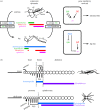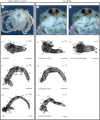A conserved genetic mechanism specifies deutocerebral appendage identity in insects and arachnids
- PMID: 25948691
- PMCID: PMC4455815
- DOI: 10.1098/rspb.2015.0698
A conserved genetic mechanism specifies deutocerebral appendage identity in insects and arachnids
Abstract
The segmental architecture of the arthropod head is one of the most controversial topics in the evolutionary developmental biology of arthropods. The deutocerebral (second) segment of the head is putatively homologous across Arthropoda, as inferred from the segmental distribution of the tripartite brain and the absence of Hox gene expression of this anterior-most, appendage-bearing segment. While this homology statement implies a putative common mechanism for differentiation of deutocerebral appendages across arthropods, experimental data for deutocerebral appendage fate specification are limited to winged insects. Mandibulates (hexapods, crustaceans and myriapods) bear a characteristic pair of antennae on the deutocerebral segment, whereas chelicerates (e.g. spiders, scorpions, harvestmen) bear the eponymous chelicerae. In such hexapods as the fruit fly, Drosophila melanogaster, and the cricket, Gryllus bimaculatus, cephalic appendages are differentiated from the thoracic appendages (legs) by the activity of the appendage patterning gene homothorax (hth). Here we show that embryonic RNA interference against hth in the harvestman Phalangium opilio results in homeonotic chelicera-to-leg transformations, and also in some cases pedipalp-to-leg transformations. In more strongly affected embryos, adjacent appendages undergo fusion and/or truncation, and legs display proximal defects, suggesting conservation of additional functions of hth in patterning the antero-posterior and proximo-distal appendage axes. Expression signal of anterior Hox genes labial, proboscipedia and Deformed is diminished, but not absent, in hth RNAi embryos, consistent with results previously obtained with the insect G. bimaculatus. Our results substantiate a deep homology across arthropods of the mechanism whereby cephalic appendages are differentiated from locomotory appendages.
Keywords: Arthropoda; antenna; chelicera; deutocerebrum; opiliones; serial homology.
© 2015 The Author(s) Published by the Royal Society. All rights reserved.
Figures




Similar articles
-
Evolution of the chelicera: a dachshund domain is retained in the deutocerebral appendage of Opiliones (Arthropoda, Chelicerata).Evol Dev. 2012 Nov-Dec;14(6):522-33. doi: 10.1111/ede.12005. Evol Dev. 2012. PMID: 23134210
-
Expression and function of spineless orthologs correlate with distal deutocerebral appendage morphology across Arthropoda.Dev Biol. 2017 Oct 1;430(1):224-236. doi: 10.1016/j.ydbio.2017.07.016. Epub 2017 Jul 29. Dev Biol. 2017. PMID: 28764892
-
Distal-less and dachshund pattern both plesiomorphic and apomorphic structures in chelicerates: RNA interference in the harvestman Phalangium opilio (Opiliones).Evol Dev. 2013 Jul-Aug;15(4):228-42. doi: 10.1111/ede.12029. Epub 2013 May 14. Evol Dev. 2013. PMID: 23809698
-
Implications of a cheliceral axial duplication in Tetragnatha versicolor (Araneae: Tetragnathidae) for arachnid deuterocerebral appendage development.Dev Genes Evol. 2021 Dec;231(5-6):131-139. doi: 10.1007/s00427-021-00678-9. Epub 2021 Jun 14. Dev Genes Evol. 2021. PMID: 34125284 Review.
-
Insect appendages and comparative ontogenetics.Dev Biol. 2005 Oct 1;286(1):57-77. doi: 10.1016/j.ydbio.2005.07.006. Dev Biol. 2005. PMID: 16112665 Review.
Cited by
-
Genomic resources and toolkits for developmental study of whip spiders (Amblypygi) provide insights into arachnid genome evolution and antenniform leg patterning.Evodevo. 2020 Aug 28;11:18. doi: 10.1186/s13227-020-00163-w. eCollection 2020. Evodevo. 2020. PMID: 32874529 Free PMC article.
-
Blastoderm segmentation in Oncopeltus fasciatus and the evolution of insect segmentation mechanisms.Proc Biol Sci. 2016 Oct 12;283(1840):20161745. doi: 10.1098/rspb.2016.1745. Proc Biol Sci. 2016. PMID: 27708151 Free PMC article.
-
Cooption of an appendage-patterning gene cassette in the head segmentation of arachnids.Proc Natl Acad Sci U S A. 2018 Apr 10;115(15):E3491-E3500. doi: 10.1073/pnas.1720193115. Epub 2018 Mar 26. Proc Natl Acad Sci U S A. 2018. PMID: 29581309 Free PMC article.
-
Taxonomic Sampling and Rare Genomic Changes Overcome Long-Branch Attraction in the Phylogenetic Placement of Pseudoscorpions.Mol Biol Evol. 2021 May 19;38(6):2446-2467. doi: 10.1093/molbev/msab038. Mol Biol Evol. 2021. PMID: 33565584 Free PMC article.
-
Eggs to long-legs: embryonic staging of the harvestman Phalangium opilio (Opiliones), an emerging model arachnid.Front Zool. 2022 Mar 4;19(1):11. doi: 10.1186/s12983-022-00454-z. Front Zool. 2022. PMID: 35246168 Free PMC article.
References
-
- Snodgrass RE. 1938. Evolution of the Annelida, Onychophora and Arthropoda. Smithson. Misc. Coll. 97, 1–159.
-
- Waloszek D, Chen J, Maas A, Wang X. 2005. Early Cambrian arthropods: new insights into arthropod head and structural evolution. Arthropod Struct. Dev. 34, 189–205. (10.1016/j.asd.2005.01.005) - DOI
Publication types
MeSH terms
Substances
Associated data
- Actions
- Actions
- Actions
LinkOut - more resources
Full Text Sources
Other Literature Sources

